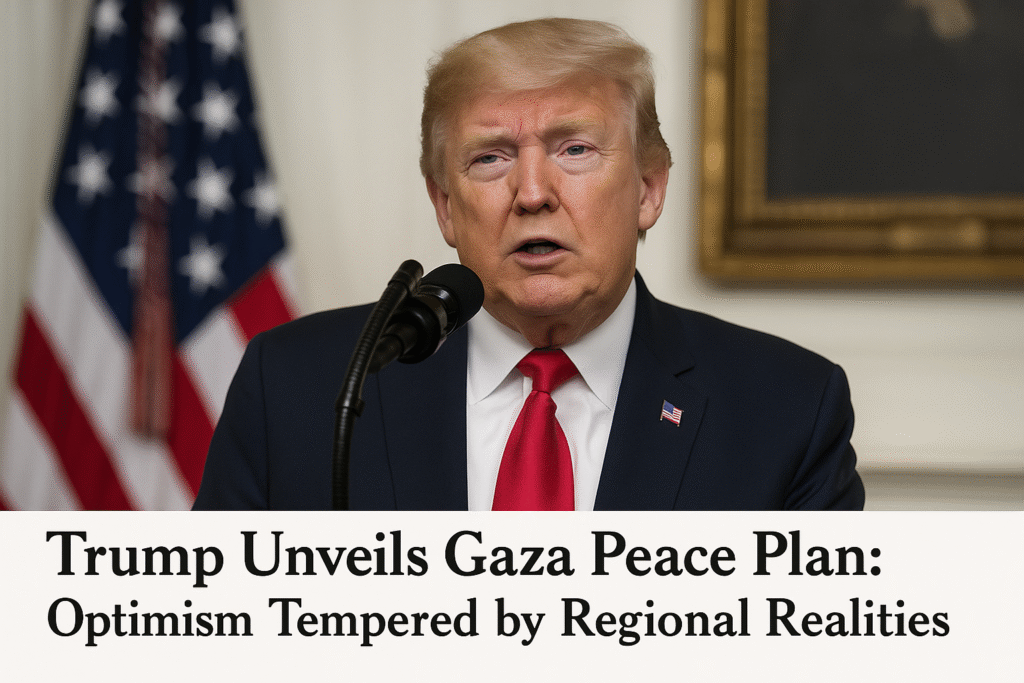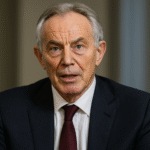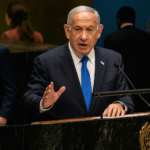By Harshit, September 30, 2025 | Washington, D.C.| 6:00 AM EDT
Former US President Donald Trump called his new 20-point Gaza peace plan “potentially one of the great days ever in civilization,” setting expectations unusually high even for a president known for hyperbole. The plan aims to end the humanitarian crisis in Gaza and secure the release of hostages held by Hamas following the October 7, 2023, attacks, but analysts urge cautious optimism.
Trump’s blueprint outlines a staged approach that includes an immediate ceasefire, hostage swaps, a phased Israeli withdrawal, disarmament of Hamas, demilitarization of Gaza, and a transitional government supervised by an international body. While ambitious, the plan faces the significant challenge of achieving swift compliance, particularly the release of remaining Israeli hostages within 72 hours of Netanyahu’s endorsement.
Humanitarian Crisis Sparks Urgency
The humanitarian situation in Gaza remains dire. Food scarcity, infrastructure collapse, and ongoing military operations have left civilians struggling to survive. Footage from Nuseirat in central Gaza shows residents gathering at charity kitchens for basic sustenance, reflecting the urgency for any initiative that promises relief.
Experts note that, despite Trump’s history of exaggerated claims, this plan appears more substantive than previous efforts, offering Palestinians a theoretical pathway to stability in the Strip. Its step-by-step approach acknowledges that decades of conflict cannot be resolved through rapid, superficial agreements.
Netanyahu’s Support and Strategic Calculations
Israeli Prime Minister Benjamin Netanyahu publicly endorsed the plan during a joint White House appearance. “I support your plan to end the war in Gaza, which achieves our war aims. It will bring back all our hostages, dismantle Hamas’ military capabilities, end its political rule, and ensure Gaza never again poses a threat to Israel,” he said.
However, observers caution that Netanyahu’s endorsement may be strategic rather than genuine. Analysts suggest he could use Trump’s plan as a means to isolate Hamas while maintaining political leverage at home. Facing a coalition with far-right elements opposed to compromise, Netanyahu may find it difficult to implement concessions that could appease Trump without risking his government’s stability.
Trump appeared prepared to exert pressure on Netanyahu, including direct discussions with the Prime Minister of Qatar to address recent Israeli violations and civilian casualties. This signals a potential willingness to leverage US influence more assertively, though Trump’s history suggests his patience for complex diplomacy may be limited.
Regional Dynamics and Hamas’ Dilemma
Hamas faces a critical choice. While the plan has gained backing from many Arab and Muslim leaders, the militant group remains isolated. Trump emphasized that “they’re the only one left” opposing the initiative. Acceptance would provide a ceasefire and potential future stability, but refusal risks continued military escalation and political isolation.
US analysts also highlight parallels with Trump’s previous peace efforts in Ukraine, where ambitious announcements failed to translate into tangible outcomes. Similarly, even with Netanyahu on board, the plan’s success depends on intricate diplomatic coordination, enforcement of timelines, and confidence-building measures among deeply mistrustful parties.
Outlook and Challenges Ahead
Trump’s plan represents a rare substantive push to end one of the most intractable conflicts in the Middle East. While it has the potential to mediate long-term Israel-Palestine relations, its immediate prospects are uncertain. Key challenges include the enforcement of hostage releases, coalition politics in Israel, and Hamas’ willingness to compromise under intense international scrutiny.
Ultimately, the effectiveness of the initiative will hinge on sustained US involvement, careful diplomatic management, and the ability of both Israeli and Palestinian leadership to balance domestic pressures with the broader goal of regional stability.







